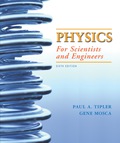
Concept explainers
(a)
The value of
(a)
Answer to Problem 75P
The value of
Explanation of Solution
Formula used:
The expression for distance
The expression for distance
The expression for distance
Calculation:
The distance
Differentiate equation (1) with respect to
Substitute
Conclusion:
Therefore, the value of
(b)
The angle of incidence.
(b)
Answer to Problem 75P
The angle of incidence is
Explanation of Solution
Formula used:
The expression for angle for incidence is given by,
Calculation:
The angle of incidence is calculated as,
Conclusion:
Therefore, the angle of incidence is
(c)
The angle of reflection.
(c)
Answer to Problem 75P
The angle of reflection is
Explanation of Solution
Formula used:
The expression for angle for reflection is given by,
Calculation:
The angle of reflection is calculated as,
Conclusion:
Therefore, the angle of reflection is
Want to see more full solutions like this?
Chapter 31 Solutions
EBK PHYSICS FOR SCIENTISTS AND ENGINEER
- The index of refraction for water is about 43. What happens as a beam of light travels from air into water? (a) Its speed increases to 43c, and its frequency decreases. (b) Its speed decreases to 34c, and its wavelength decreases by a factor of 34. (c) Its speed decreases to 34c, and its wavelength increases by a factor of 43. (d) Its speed and frequency remain the same. (e) Its speed decreases to 34c, and its frequency increases.arrow_forwardFor specular reflection, what is the situation with an angle of incidence of (a) 0 and (b) 90?arrow_forwardA ray of light passes from medium A to medium B. If the angle of incidence is 30° and the angle of refraction is 38°, which of the following statements is TRUE? A. The index of refraction of A is greater than the index of refraction of B. B. The index of refraction of A is lower than the index of refraction of B. C. A and B have equal indices of refraction. D. It cannot be determined unless at least one index of refraction was given. E. It cannot be determined unless the types of material of the two media were given.arrow_forward
- A light ray travels from air (n=1.00) into a crown glass (n=1.52) with an angle of incidence of 49 degrees. The light ray continues to travel through the crown glass material into the diamond (n=2.42). At what angle does the light ray make with the normal line as it enters the diamond? a.) 12 deg b,) 30 deg c.) 48 deg d.) 18 degarrow_forwardFind the angle of incidence at which a light beam traveling from a medium having the index of refraction n1 = 2.7 to another medium having the index of refraction n2 = 1.4 suffers a total internal reflection.arrow_forwardIf the incoming ray hits the horizontal mirror farther to the right, is the angle the outgoing ray makes with the vertical greater than u, equal to u, or less than u?arrow_forward
- A ray of light is reflected by two parallel mirrors (1) and (2) at points A and B. The ray makes an angle of 30° with the a parallel line between the two mirrors. Calculate for (a) the angle of reflection at the point of incidence A; (b) the angle of reflection at the point of incidence B (c) the apporxinatenumber of reflections made by the two mirrors if the distance between the two mirrors id d = 4 cm and the length L of the two mirror system is 3 meters, (d) In a real system, at each reflection, there are losses of the light energy travelling between the two mirrors. If L and d are fixed, what can be done to decrease the number of reflections on the mirrors and hence the energy lost by reflection?arrow_forwardWhat happens when light moves from a medium with a high refractive index into a medium with a lower refractive index at an angle of incidence of less than 90°? a) The ray of light speeds up and bends towards the normal. b) The ray of light continues on the exact same path. c) The ray of light speeds up and bends away from the normal. d) The ray of light continues on the exact same path, but at a faster speed.arrow_forwardLight, when incident on a given surface, presents a reflected and a refracted component. When the reflected beam is perpendicular to the refracted beam, the angle of incidence θᵢ is called Brewster's angle. If a beam of light is initially in air with index of refraction n₁ = 1 and is incident on a glass surface (index of refraction n₂ = 1.5), Brewster's angle is: a)82.9° b)36.3° c)75.4° d)62.9° e)56.3° f)45.7°arrow_forward
- What happens when light moves from a medium with a low refractive index into a medium with a higher refractive index at an angle of incidence = 90°? a) The ray of light speeds up and bends away from the normal. b) The ray of light continues on the exact same path, but at a slower speed. c) The ray of light continues on the exact same path, but at a faster speed. d) The ray of light slows down and bends towards the normal.arrow_forwardAt what angle of incidence should a light beam strike a glass slab of refractive index ✓3, such that the reflected and the refracted rays are perpendicular to each other?arrow_forwardA ray of light is incident on the mid-point of a glass prism surface at an angle of 23.4° with the normal. For the glass, n = 1.60, and the prism apex angle is 51.8°. What is the angle of incidence at the glass-to-air surface on the side opposite where the ray exits the prism?arrow_forward
 Principles of Physics: A Calculus-Based TextPhysicsISBN:9781133104261Author:Raymond A. Serway, John W. JewettPublisher:Cengage Learning
Principles of Physics: A Calculus-Based TextPhysicsISBN:9781133104261Author:Raymond A. Serway, John W. JewettPublisher:Cengage Learning An Introduction to Physical SciencePhysicsISBN:9781305079137Author:James Shipman, Jerry D. Wilson, Charles A. Higgins, Omar TorresPublisher:Cengage Learning
An Introduction to Physical SciencePhysicsISBN:9781305079137Author:James Shipman, Jerry D. Wilson, Charles A. Higgins, Omar TorresPublisher:Cengage Learning

